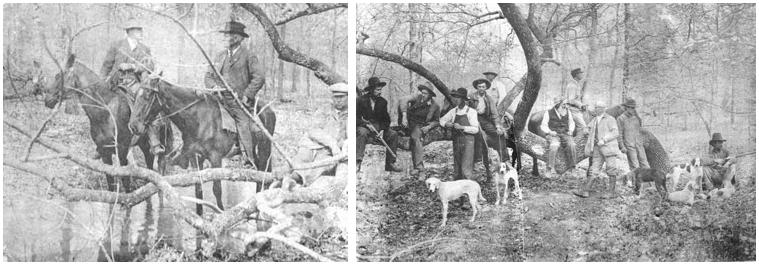The Briscos












Looking Back In The Journal
The Briscos of Howell County
Fox Trotting Horses have been used in Howell County, MO since pioneer times and this Ozarks community has had major influence on the development of the Missouri Fox Trotting Horse Breed. Howell County has the distinction of producing two of MFTHBA’s five presidents: Joe Hinds, of Willow Springs, who led the re-organization in 1958, and Ray Cannon of West Plains, a greatgrandson of Tom Brisco, one of Howell county’s prominent pioneers and horsemen.
Tom Brisco and his wife left Decatur, Alabama in an ox-drawn wagon and traveled to Howell County in 1859.
They homesteaded land six miles south of West Plains, MO, a small settlement centered around a large spring (The spring is now buried beneath the town’s library).
They left the deep south because they feared Civil War. Nobody could foresee the tragedies and hardships that would stalk the border region where they settled.
Most of the people who settled in the Ozarks came from the south and they feared Lincoln’s election would mean war. The national parties split and there were four candidates for President in 1860. Lincoln did not receive one vote in Howell County; he wasn’t even on the ballot in nearby Arkansas.
West Plains was occupied by Confederate troops in December of 1861, then overrun by Union troops. Both armies confiscated food, horses, and property in Howell County. In their wake came bands of marauding guerillas and pernicious jayhawkers who stole very horse and moveable object in sight. The local bushwhackers came out at night to rob, and kill and burn. Even food had to be cleverly hidden.
While the Brisco men were away at war, bushwhackers stole everything of value, including the quilt pallet from beneath a sick child. The Brisco women fled to the protection of the Union garrison at Ft. Wyman at Rolla. They remained there until the war ended, but the little boy did not survive.
When the Civil War ended Howelll County had about 300 people left, everyone that could go away had done so. There were only a few farm houses left standing and the town of West Plains had been completely burned, with the exception of one small cabin.
Henry Brisco was born in Howell County in 1866.
He homesteaded land near Lanton, 1 1/2 miles north of the Arkansas border. Like his father, Tom Brisco, Henry was an excellent rider and an ardent lover of good saddle horses and good hunting dogs. He became a well-known farmer and stockman and served two terms as Howell County Assessor. Later he was a county judge.
Henry bought a 16 hand, chestnut sorrel Fox Trotting gelding from Whit Lambert, a West Plains stock dealer.
He called the horse Whit, after his former owner and used him for eight years assessing Howell County, beginning in 1912. No picture of Whit could be located by press time, but it’s not unlikely that one does exist for he was perhaps the most widely recognized horse ever used in Howell County.
Whit was raw-boned and Kentucky bred. He was prized for his ground consuming Fox Trot, his enormous stamina, and his good sense. Whit learned the route so well he knew when the weekends came. Early in the week Henry would turn him loose to graze while he filled out assessment forms. But along about Friday he tied Whit up when he got off, otherwise the horse would go home without him. Whit would tilt his head sideways so the the bridle reins wouldn’t drag beneath his feet and fox trot home from anywhere in the county at week’s end.
Ovle House, one of the MFTHBA’s founders, recalls Henry Brisco staying overnight at their farm.
“Dad would tell Henry to bring his saddle bag and come into the house. My job was to water Whit, put him in the barn, feed him and rub him down a little. That tickled me because I got to ride him to the pond and back. He was a mighty fine horse. Dad kept a little barn with four stalls just for the comers and goers…the cattle buyers, the preachers, the assessor and such. Whit never was fat, but he sure was tough.
Henry Brisco and Dad were great friends. They’d set up late talking. Henry always brought news with him. My folks would have been real put out if he hadn’t stayed with us.
Tom Brisco II remembers plowing Whit until the first of June because assessing couldn’t start until then. Whit was game in harness, but Tom had to use a jockey stock to keep him from winding. “He was a saddle horse,” says Tom, “and limber.”
Henry Brisco bought a Model T Ford in 1914, but the roads were so bad and its tires so fragile, the automobile could only be used around West Plains or to travel to another town. To get the job done, the Howell County Assessor depended on his Fox Trotting Horse. Whit remained in the Brisco family for many, many years and died in their care at an advanced old age.
This 1910 Howell County hunting party paused for a photographer beside a spring-fed pond. Pioneer Tom Brisco is seated on the tree trunk, fith figure from the right (full beard). His son, Henry Brisco, is also seated on the tree trunk, seventh figure from the right (holding a gun and dog). Henry’s statement, “That horse can carry you. Sit up and balance!” is still good advice for horsemen today.

Tom Brisco II on the McCormick Ranch at Scottsdale, Arizona, in the mid-forty’s, where he supervised the famous Angus herd owned by their heirs to the farm implement fortune. He returned to West Plains in 1948 and became a Skelly Oil agent. Now nearly 80, Tom still owns and rides Fox Trotters.

Howell County Assessor, Henry Brisco, bought a car in 1914, but continued to use his Fox Trotter, Whit, on the job. Whit was reliable, the Model T wasn’t.

